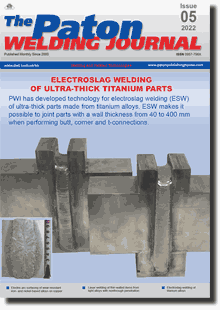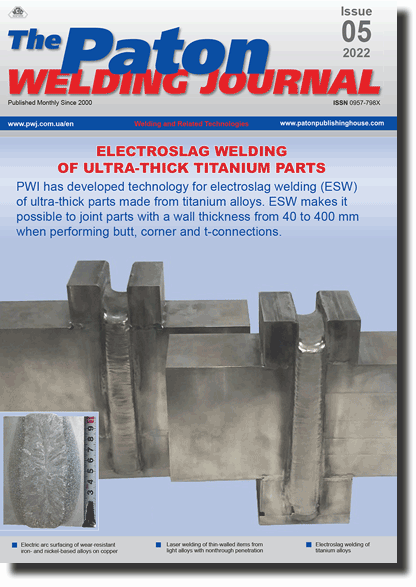| 2022 №05 (02) |
DOI of Article 10.37434/tpwj2022.05.03 |
2022 №05 (04) |

The Paton Welding Journal, 2022, #5, 16-25 pages
Selection of parameters of laser welding of thin-walled items from light alloys with nonthrough thickness penetration
V.M. Korzhyk1, V.Yu. Khaskin1, S.I. Peleshenko2, A.A. Grynyuk3, Dong Chunlin1, E.V. Illyashenko2, Yuhui Yao4
1China-Ukraine Institute of Welding, Guangdong Academy of Sciences, Guangdong Provincial Key Laboratory of Advanced Welding Technology, Guangzhou, 510650, China
2E.O. Paton Electric Welding Institute of the NASU. 11 Kazymyr Malevych Str., 03150, Kyiv, Ukraine. E-mail: vnkorzhyk@gmail.com
3National Technical University of Ukraine «Igor Sikorsky Kyiv Polytechnic Institute» 37 Peremohy Ave., 03056, Kyiv, Ukraine
4Shenzhen Hanzhizi Technology Co., Ltd. 6th Floor, Building B, Bantian International Center, 5 Huancheng South Road, Longgang District, Shenzhen, Guangdong, China
Abstract
Light metal alloys (in particular, beryllium and aluminium) are applied in different engineering fields, for instance for fabrication of rocket and aircraft elements. When designing such engineering elements, there is the need to produce welded joints with different types of welds. Laser welding with nonthrough thickness penetration welds can be used for item sealing, welding-on flanges and welding thin-walled structures of up to 2‒3 mm thickness. Toxic fumes form in welding beryllium alloys. Such a peculiarity requires reducing the number of technological experiments, aimed at selection of mode parameters. An up-to-date approach to solving the problem of light alloy welding is performance of preliminary calculated determination of mode parameters with their further experimental verification. Technological verification can be performed on high-strength aluminium alloys close by their physico-mechanical characteristics to beryllium alloys. Therefore, this work is devoted to preliminary determination of mode parameters of laser welding by a sealing weld with nonthrough thickness penetration of thin-walled flanges of cylindrical parts and box-shaped items from light metals and alloys based on Be and Al, taking into account the temperature of postweld heating. A procedure of preliminary calculated determination of mode parameters of laser welding of parts from a beryllium-based alloy is proposed in the work, which is suitable for both through-thickness and nonthrough-thickness penetration. Nonthrough-thickness penetration can be applied for welding-on flanges by a sealing weld. Experimental verification on samples from alloys of Al–Zn–Mg–Cu system and comparison with published data on beryllium alloy welding showed that the error of the proposed procedure is in the range of up to 15–20 %.
Keywords: laser welding, light alloys, penetration, mode parameters, error, pores, cracks
Received: 14.04.2022
Accepted: 08.08.2022
References
1. Bunaziv, I., Akselsen, O.M., Ren, X. et al. (2021) A Review on Laser-Assisted Joining of Aluminium Alloys to Other Metals. Metals, 11, 1680, 1-40. https://doi.org/10.3390/met111116802. Criss, E.M. (2015) Surrogacy of Beryllium Welds and Heat Transfer in Metals, Dissertation for the degree Doctor of Philosophy (Mechanical Engineering), University of California, San Diego (USA) - 129 p. Permalink: http://escholarship.org/uc/item/8sx939v4
3. Zhao, T., Sato, Y.S., Xiao, R. et al. (2020) Laser pressure welding of Al-Li alloy 2198: effect of welding parameters on fusion zone characteristics associated with mechanical properties. High Temperature Materials and Processes, 39, 1, 146-156. https://doi.org/10.1515/htmp-2020-0047
4. Miyagi, M., Wang, H., Yoshida, R. et al. (2018). Effect of alloy element on weld pool dynamics in laser welding of aluminum alloys. Scientific Reports, 8, 12944. 1-10. https://doi.org/10.1038/s41598-018-31350-4
5. Hill ,M., Damkroger, B.K., Dixon, R.D., Robertson, E. (1990) Beryllium weldability, Los Alamos National Laboratory, Materials Weldability Symposium, ASM Materials Week. Detroit, Michigan (USA). Permalink: https://www.researchgate.net/publication/236557474'); ?>
6. Ahn, J., Chen, L., He, E. et al. (2018) Optimisation of process parameters and weld shape of high power Yb-fibre laser welded 2024-T3 aluminium alloy. Journal of Manufacturing Processes, 34, Part A., 70-85. https://doi.org/10.1016/j.jmapro.2018.05.028
7. Veness, R., Simmons, G., Dorn, C. (2011) Development of beryllium vacuum chamber technology for the LHC, Proceedings of IPAC2011, San Sebastián, Spain, TUPS024, 1578-1580.
8. Doshi, S.J., Gohi, A.V., Mehta, N.D., Vaghasiya, S.R. (2018) Challenges in Fusion Welding of Al alloy for Body in White, Materials Today: Proceedings, 5, 2, 1, 6370-6375. https://doi.org/10.1016/j.matpr.2017.12.247
9. Hanafee, J.E., Ramos, T.J. (1995). Laser Fabrication of Beryllium Components. 2nd International Energy Agency International Workshop on Beryllium Technology for Fusion. Moran, Wyoming (USA), September 6-8. https://doi.org/10.2172/132761
10. Чиркин В.С. (1968) Теплофизические свойства материалов ядерной техники. Справочник. Москва, Атомиздат. Chirkin, V.S. (1968) Thermophysical properties of materials of nuclear engineering: Handbook. Moscow, Atomizdat [in Russian].
11. Khaskin, V.Yu., Korzhik, V.N., Sydorets, V.N. et al. (2015) Improving the efficiency of hybrid welding of aluminum alloys. The Paton Welding J., 12, 14-18. https://doi.org/10.15407/tpwj2015.12.03
12. Miller, E., Liu, S. (2018) Laser Welding of Aluminum Alloys. ASM HANDBOOK ONLINE. https://doi.org/10.31399/asm.hb.v02a.a0006502
13. Hanafee, J.E., Ramos, T.J. (1995) Laser Fabrication of Beryllium Components. 2nd International Energy Agency International Workshop on Beryllium Technology for Fusion. Moran, Wyoming (USA), September 6-8. https://doi.org/10.2172/132761
14. Campbell, R.P., Dixon, R.D., Liby, A.L. (1978) Electron-beam fusion welding of beryllium. Rockwell International (USA), RFP-2621, January 1, 1978. https://doi.org/10.2172/5172167
15. Хаскин В.Ю., Шулым В.Ф., Бернацкий А.В. и др. (2012) Лазерная сварка в атмосфере низкого давления. Вісник НУК, 5, 167-169. Khaskin, V.Yu., Shulym, V.F., Bernarsky, A.V. et al. (2012) Laser welding in low pressure atmosphere. Visnyk NUK, 5, 167-169 [in Russian].
Suggested Citation
V.M. Korzhyk, V.Yu. Khaskin, S.I. Peleshenko, A.A. Grynyuk, Dong Chunlin, E.V. Illyashenko, Yuhui Yao (2022) Selection of parameters of laser welding of thin-walled items from light alloys with nonthrough thickness penetration. The Paton Welding J., 05, 16-25.The cost of subscription/purchase order journals or individual articles
| Journal/Currency | Annual Set | 1 issue printed |
1 issue |
one article |
| TPWJ/USD | 384 $ | 32 $ | 26 $ | 13 $ |
| TPWJ/EUR | 348 € | 29 € | 24 € | 12 € |
| TPWJ/UAH | 7200 UAH | 600 UAH | 600 UAH | 280 UAH |
| AS/UAH | 1800 UAH | 300 UAH | 300 UAH | 150 UAH |
| AS/USD | 192 $ | 32 $ | 26 $ | 13 $ |
| AS/EUR | 180 € | 30 € | 25 € | 12 € |
| SEM/UAH | 1200 UAH | 300 UAH | 300 UAH | 150 UAH |
| SEM/USD | 128 $ | 32 $ | 26 $ | 13 $ |
| SEM/EUR | 120 € | 30 € | 25 € | 12 € |
| TDNK/UAH | 1200 UAH | 300 UAH | 300 UAH | 150 UAH |
| TDNK/USD | 128 $ | 32 $ | 26 $ | 13 $ |
| TDNK/EUR | 120 € | 30 € | 25 € | 15 € |
AS = «Automatic Welding» - 6 issues per year;
TPWJ = «PATON WELDING JOURNAL» - 12 issues per year;
SEM = «Electrometallurgy Today» - 4 issues per year;
TDNK = «Technical Diagnostics and Non-Destructive Testing» - 4 issues per year.


